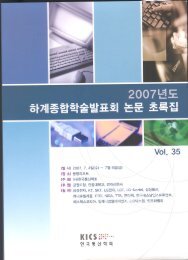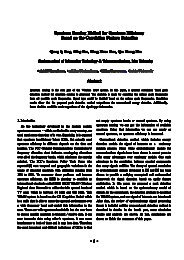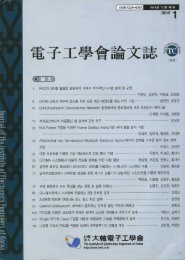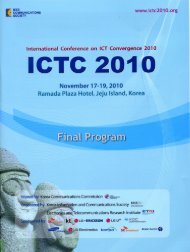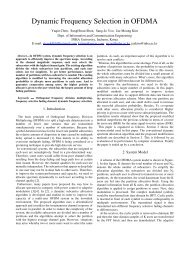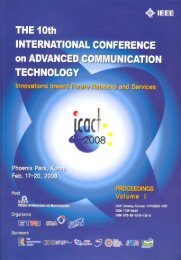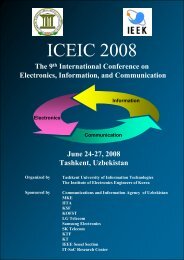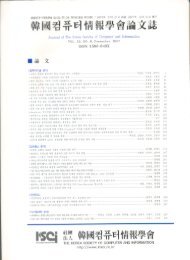Dynamic Frequency Allocation Based On Graph Coloring and Local ...
Dynamic Frequency Allocation Based On Graph Coloring and Local ...
Dynamic Frequency Allocation Based On Graph Coloring and Local ...
Create successful ePaper yourself
Turn your PDF publications into a flip-book with our unique Google optimized e-Paper software.
<strong>Dynamic</strong> <strong>Frequency</strong> <strong>Allocation</strong> <strong>Based</strong> <strong>On</strong> <strong>Graph</strong> <strong>Coloring</strong> <strong>and</strong> <strong>Local</strong><br />
Bargaining for Multi-Cell WRAN System<br />
Abstract—WRAN system is a new st<strong>and</strong>ard under<br />
establishment to improve the efficiency of spectrum utilization<br />
<strong>and</strong> spectrum allocation scheme is one of its key techniques. In<br />
this paper, one spectrum allocation scheme called “pre-allocation<br />
<strong>and</strong> local bargaining” is proposed to avoid intra-cell <strong>and</strong> inter-cell<br />
co-channel interference among users. <strong>Based</strong> on color sensitive<br />
graph coloring problem <strong>and</strong> local bargaining, our scheme has the<br />
ability to guarantee the fairness among users <strong>and</strong> satisfy the<br />
user’s minimum requirement of spectrum b<strong>and</strong>width.<br />
Index terms—dynamic spectrum allocation, color sensitive<br />
graph coloring, local bargaining, WRAN system<br />
A. INTRODUCTION<br />
In conventional fixed spectrum allocation schemes, to<br />
eliminate interference between different wireless<br />
technologies, policies allocate a fixed spectrum splice to<br />
each wireless technology. The static spectrum<br />
assignment leads to underutilization of electromagnetic<br />
resource. Cognitive Radio (CR) [1], based on softwaredefined<br />
radio, has been proposed as the technology to<br />
improve the efficiency of the spectrum. In CR, spectrum<br />
utilization is significantly improved by making it<br />
possible for a secondary user to access a spectrum hole<br />
unoccupied by the primary user at the right location <strong>and</strong><br />
time. <strong>Based</strong> on the proposed CR technique, the IEEE<br />
802.22 WRAN st<strong>and</strong>ard is being established. WRAN<br />
system utilizes the spectrum holes of the DTV service,<br />
of which the operating spectrum b<strong>and</strong> is between<br />
54MHz <strong>and</strong> 862MHz. This st<strong>and</strong>ard is intended to<br />
enable deployment of interoperable 802 multivendor<br />
wireless regional area network products, to facilitate<br />
competition in broadb<strong>and</strong> access by providing<br />
alternatives to wireline broadb<strong>and</strong> access <strong>and</strong> extending<br />
the deployability of such systems into diverse<br />
geographic areas, including sparsely populated rural<br />
areas, while preventing harmful interference to<br />
incumbent licensed services in the TV broadcast b<strong>and</strong>s<br />
[2]. Sensing <strong>and</strong> dynamic frequency selection are two<br />
key techniques of WRAN system. During sensing<br />
procedure, necessary information such as the available<br />
spectrum information is assembled <strong>and</strong> then dynamic<br />
frequency selection is processed. The objective of our<br />
dynamic frequency selection is not only maximizing the<br />
spectrum utilization <strong>and</strong> also guaranteeing the fairness<br />
1-4244-0574-2/06/$20.00 (C)2006 IEEE<br />
Yuqin Chen, Ning Han, SungHwan Shon, <strong>and</strong> Jae Moung Kim<br />
Graduate School of IT <strong>and</strong> Telecommunication<br />
INHA University, Incheon, Korea<br />
among users, which means each user should be assigned<br />
at least the minimum required b<strong>and</strong>width.<br />
To achieve our target, dynamic spectrum allocation<br />
scheme in Ad-hoc networks is used for reference, the<br />
channel assignment problem is reduced to a graph multicoloring<br />
problem by mapping each channel into a color<br />
[3][4]. This topology-optimized allocation algorithm<br />
begins with no prior information, <strong>and</strong> assigns each user<br />
an optimal assignment. In our work, to avoid intra- <strong>and</strong><br />
inter-cell co-channel interference among users, the graph<br />
coloring method via local bargaining is adopted <strong>and</strong> an<br />
allocation procedure is proposed to provide the fairness<br />
among users <strong>and</strong> reduce the complexity caused by new<br />
arrival <strong>and</strong> mobile users.<br />
We propose an allocation procedure called “preallocation<br />
<strong>and</strong> local bargaining” in this paper. In the<br />
beginning, necessary information such as the users’<br />
position information <strong>and</strong> the available channel<br />
information should be assembled by initialization. After<br />
initialization, all users are pre-allocated some channels<br />
according to the color sensitive coloring graph.<br />
Unfortunately, it is probable that some users cannot<br />
achieve enough channels to satisfy its minimum<br />
transmission data rate. To avoid the unfairness among<br />
users, local bargaining is processed then in order to meet<br />
the minimum required b<strong>and</strong>width for all users.<br />
B. BACKGROUND OF SPECTRUM ALLOCATION<br />
1st. Assumptions<br />
We assume that the available spectrum is divided into<br />
a set of spectrum b<strong>and</strong>s, <strong>and</strong> that b<strong>and</strong>s differ from each<br />
other in b<strong>and</strong>width <strong>and</strong> transmission range. We also<br />
assume that spectrum b<strong>and</strong>s are orthogonal, <strong>and</strong> that<br />
users can utilize a number of spectrum b<strong>and</strong>s at one time.<br />
It is also assumed that the users (CPE in WRAN case)<br />
have assembled the available spectrum information<br />
through sensing procedure. The users in the same cell<br />
cannot transmit data between base station by the same<br />
b<strong>and</strong> simultaneously due to the intra-cell co-channel<br />
interference. What’s more, users from adjacent cells<br />
locating within a constrained distance also suffer<br />
conflicts when they select the same channels at the same<br />
time. To solve this, a simplified interference metric is



